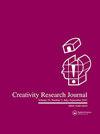Inaugural Issue of CRJ as the Journal of the Society for the Neuroscience of Creativity: Introduction to the Special Issue
IF 2.5
3区 心理学
Q2 PSYCHOLOGY, EDUCATIONAL
引用次数: 0
Abstract
It is with considerable excitement that I mark the publication of this inaugural special issue, signifying a new era at Creativity Research Journal: CRJ is now the official journal of The Society for the Neuroscience of Creativity (SfNC). In joining forces, CRJ gains new reach among the SfNC’s global network of scholars, educators, artists, and innovators, and SfNC gains a new platform – built on CRJ’s rich tradition – for disseminating rigorous and thought-leading creativity scholarship. I am also pleased to note the adoption of CRJ’s new cover design, which can be found on the cover of this issue, and which is based on the winning entry to SfNC’s design concept competition (the winner was selected by the votes of SfNC membership). The partnership between CRJ and SfNC has been several years in the making, and it is with gratitude to the many efforts of the SfNC Executive Committee, the SfNC Advisory Board, the CRJ Editorial Board, members of the Taylor & Francis team, and others that I welcome this auspicious beginning. While affiliation with SfNC is an important development for the future of CRJ, this transition does not represent a fundamental change in CRJ’s longstanding mission and scope. CRJ will remain committed to publishing top-notch work that reflects the broad and diverse areas of scholarship that constitute the field of creativity research. Indeed, this breadth of scope is aligned with the broad scope of SfNC. While a core component SfNC’s work is to foster approaches to understandand bolster creative thinking and performance at the neural level, SfNC actively welcomes and supports research accross the spectrum of creativity scholarship. SfNC’s mission engages the arts, industry, and education as well as the sciences, and extends to all influences, contexts, applications, and outcomes of creative processes in individuals, organizations, artificial intelligence, and social systems. This inaugural special issue of CRJ represents the breadth of our field, and the vision of SfNC. The special issue is a remarkable collection of the work of fieldleading scholars and ranges from the development of fundamental theory to notable empirical and methodological advances. The quality and quantity of this work was so strong that it became necessary to publish this inaugural issue in two volumes, one appearing in 2023 and the other in 2024. Many of the papers included In these two volumes operate at the nexus of the theoretical and the empirical. Jonathan Plucker reviews current issues, recent advances, and future directions in creativity assessment, including the need for psychometric quality standards and the use of machine learning. Dean Keith Simonton provides an update on the Blind Variation and Selective Retention Theory of Creativity, emphasizing recent developments and the theory’s research implications. Yoed Kenett, Stacey Humphries, and Anjan Chatterjee discuss the shared psychological and neural mechanisms underlying curiosity, creativity, and aesthetics, highlighting the role of information-seeking and memory systems. Steve Smith and Zsolt Beda challenge the concept of unconscious work in creativity, proposing a testable theory and alternative explanations for incubation effects. Robert Weisberg discusses conflicting theoretical views in creativity studies, examining the remote associates perspective and contrasting it with real-life creative thinking. Keith Holyoak, Nicholas Ichien, and Hongjing Lu explore the role of analogies in the creative thinking process, asserting that distant analogies foster a creative mind-set by enabling novel representations of unfamiliar situations through relational similarities. James Kaufman, Roger Beaty, Yoed Kenett and I introduce the process definition of creativity, defining creativity as a process with core elements (internally-directed attention constrained by a generative goal), as distinct from the descriptors of products (novel and useful) that are the basis of the “standard” definition, then highlighting the alignment of the process definition with neural evidence as well as its capacity to clarify ontological distinctions. Drawing methodological direction from theoretical foundations, Ross Anderson, Ron Beghetto, Vlad Glaveanu, and Marina Basu discuss the limitations of the consensual assessment technique (CAT) in creativity assessment and propose the Divergent, Open-Ended, and Generative (DOG) approach to interpreting creative artifacts. Rex Jung and Dan Hunter call for more imaginative research into CREATIVITY RESEARCH JOURNAL 2023, VOL. 35, NO. 3, 289–290 https://doi.org/10.1080/10400419.2023.2235201创刊号CRJ作为创造力神经科学学会杂志:特刊简介
我怀着相当激动的心情纪念这期创刊特刊的出版,标志着《创造力研究杂志》进入了一个新时代:《CRJ》现在是创造力神经科学学会(SfNC)的官方期刊。通过联合,CRJ在北卡罗来纳大学的全球学者、教育工作者、艺术家和创新者网络中获得了新的影响力,北卡罗来纳大学在CRJ丰富的传统基础上获得了一个新的平台,用于传播严谨和思想领先的创造力学术。我也很高兴地注意到CRJ的新封面设计的采用,这可以在本期封面上找到,它是基于SfNC设计概念竞赛的获奖作品(获奖者由SfNC成员投票选出)。CRJ和SfNC之间的伙伴关系已经建立了好几年,我怀着对SfNC执行委员会、SfNC咨询委员会、CRJ编辑委员会、Taylor&Francis团队成员和其他人的许多努力的感谢,欢迎这一良好的开端。虽然与SfNC的关系是CRJ未来的一个重要发展,但这一转变并不代表CRJ长期使命和范围的根本变化。CRJ将继续致力于出版反映创意研究领域广泛多样的学术领域的顶尖作品。事实上,这种范围的广度与SfNC的广泛范围是一致的。虽然SfNC工作的核心组成部分是培养在神经水平上理解和支持创造性思维和表现的方法,但SfNC积极欢迎并支持跨创造性学术领域的研究。SfNC的使命涉及艺术、工业、教育和科学,并延伸到个人、组织、人工智能和社会系统中创造性过程的所有影响、背景、应用和结果。CRJ的创刊特刊代表了我们领域的广度和SfNC的愿景。该特刊汇集了领域领先学者的杰出成果,从基础理论的发展到显著的实证和方法论进步。这部作品的质量和数量如此之高,以至于有必要将这本创刊号分两卷出版,一卷在2023年出版,另一卷在2024年出版。这两卷中的许多论文都是在理论和实证的结合点上发表的。Jonathan Plucker回顾了创造力评估的当前问题、最新进展和未来方向,包括心理测量质量标准的必要性和机器学习的使用。院长Keith Simonton介绍了创造力的盲变异和选择性保留理论的最新进展,强调了该理论的研究意义。Yoed Kenett、Stacey Humphries和Anjan Chatterjee讨论了好奇心、创造力和美学背后的共同心理和神经机制,强调了信息寻求和记忆系统的作用。Steve Smith和Zsolt Beda挑战了创造力中无意识工作的概念,提出了一个可测试的理论和孵化效应的替代解释。Robert Weisberg讨论了创造力研究中相互矛盾的理论观点,考察了远程联想的视角,并将其与现实生活中的创造性思维进行了对比。Keith Holyoak、Nicholas Ichien和Hongjing Lu探讨了类比在创造性思维过程中的作用,声称遥远的类比通过关系相似性对陌生情况进行新颖的表征,从而培养了创造性思维。James Kaufman、Roger Beaty、Yoed Kenett和我介绍了创造力的过程定义,将创造力定义为具有核心元素(受生成目标约束的内部定向注意力)的过程,与作为“标准”定义基础的产品描述符(新颖和有用)不同,然后强调过程定义与神经证据的一致性,以及其澄清本体论区别的能力。Ross Anderson、Ron Begheto、Vlad Glaveanu和Marina Basu从理论基础上汲取方法论指导,讨论了共识评估技术(CAT)在创造力评估中的局限性,并提出了解释创造性工件的分歧、开放和生成(DOG)方法。Rex Jung和Dan Hunter呼吁对《创造力研究杂志2023》第35卷第3期289–290进行更具想象力的研究https://doi.org/10.1080/10400419.2023.2235201
本文章由计算机程序翻译,如有差异,请以英文原文为准。
求助全文
约1分钟内获得全文
求助全文
来源期刊

Creativity Research Journal
Multiple-
CiteScore
5.10
自引率
7.70%
发文量
52
期刊介绍:
Creativity Research Journal publishes high-quality, scholarly research capturing the full range of approaches to the study of creativity--behavioral, clinical, cognitive, crosscultural, developmental, educational, genetic, organizational, psychoanalytic, psychometrics, and social. Interdisciplinary research is also published, as is research within specific domains (e.g., art, science) and research on critical issues (e.g., aesthetics, genius, imagery, imagination, incubation, insight, intuition, metaphor, play, problem finding and solving). Integrative literature reviews and theoretical pieces that appreciate empirical work are extremely welcome, but purely speculative articles are not published. Readers are encouraged to send commentaries, comments, and evaluative book reviews.
 求助内容:
求助内容: 应助结果提醒方式:
应助结果提醒方式:


